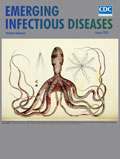
Volume 26, Number 8—August 2020
Research
Increased Sensitivity of Plasmodium falciparum to Artesunate/Amodiaquine Despite 14 Years as First-Line Malaria Treatment, Zanzibar
Mwinyi Msellem, Ulrika Morris, Aungpaing Soe, Faiza B. Abbas, Abdul-Wahid Ali, Rory Barnes, Paolo Frumento, Abdullah S. Ali, Andreas Mårtensson, and Anders Björkman
Abstract
Artemisinin-based combination therapies (ACTs) are first-line treatments for uncomplicated Plasmodium falciparum malaria. ACT resistance is spreading in Asia but not yet in Africa. Reduced effects of ACT partner drugs have been reported but with little information regarding widely used artesunate/amodiaquine (ASAQ). We studied its efficacy in Zanzibar after 14 years as first-line treatment directly by an in vivo, single-armed trial and indirectly by prevalences of different genotypes in the P. falciparum chloroquine-resistance transporter, multidrug-resistance 1, and Kelch 13 propeller domain genes. In vivo efficacy was higher during 2017 (100%; 95% CI 97.4%–100%) than during 2002–2005 (94.7%; 95% CI 91.9%–96.7%) (p = 0.003). Molecular findings showed no artemisinin resistance–associated genotypes and major increases in genotypes associated with high sensitivity/efficacy for amodiaquine than before ASAQ was introduced. Thus, the efficacy of ASAQ is maintained and appears to be increased after long-term use in contrast to what is observed for other ACTs used in Africa.
Artemisinin-based combination therapy (ACT) has been first-line treatment for uncomplicated Plasmodium falciparum malaria globally for the past 10–15 years and has contributed greatly to a reduction of malaria illnesses and deaths during 2005–2015 (1,2). However, artemisinin resistance emerged in Cambodia during 2008, where it then spread and even developed de novo throughout the Great Mekong Region (3,4). Possible resistance has been reported from eastern India (5) and, Guyana in South America (6) but not yet from Africa (4). However, ACT resistance represents a continuous threat in contexts such as Zanzibar, where numerous long-distance visitors represent a special risk for imported artemisinin-resistant malaria parasites. Chloroquine resistance entered eastern Africa most probably from India in late 1970s (7). In addition, selection of resistance/tolerance to the slowly eliminated long-acting partner drugs in ACT (e.g., amodiaquine) is expected, especially in highly malaria-endemic areas of Africa (8–10), which could result in relatively reduced ACT cure rates and reduced protection against artemisinin resistance (11). Currently, however, complete ACT resistance has developed and spread only in Asia (e.g., Cambodia) (12).
In Zanzibar, malaria transmission has been reduced substantially after new and reinforced malaria tools and interventions, including ACT for uncomplicated malaria (2), were implemented. The reduced parasite biomass on the islands of Zanzibar has resulted in an expected selection (bottleneck) of the parasite populations (2,13), which under strong drug exposure might select for drug resistance. The first-line ACT in Zanzibar has been artesunate/amodiaquine (ASAQ) since 2003, plus recently added single, low-dose primaquine. Artemether/lumefantrine was used as second-line treatment when ACT was first used, followed by quinine when treatment guidelines were revised in 2009 (2). Free access throughout the health systems has resulted in sustained high population coverage and compliance to ASAQ (2,14,15). The partner drug amodiaquine is relatively short-lived (half-life 2–8 hours) and is primarily metabolized to its main biologically active metabolite desethyl-amodiaquine, which has a longer terminal elimination half-life (>7 days) (16).
Efficacy verses resistance to ACTs is primarily assessed by the in vivo response to standard treatment in which early clearance determines the effect of the artemisinin component, and the cure rate by days 28 or 42 after treatment determines the effect of the combination, especially that of the partner drug (17). Tolerance/resistance to the ACT components can also be estimated separately by genetic determination of different drug-resistance associated polymorphisms. A few longitudinal studies in Africa have examined tolerance/resistance trends to ACTs, especially to artemether/lumefantrine, suggesting largely maintained treatment efficacy but also higher prevalences of genotypes associated with tolerance to lumefantrine (18,19). However, there is a lack of combining longitudinal in vivo cure rates and molecular findings, particularly in relation to ASAQ, the second most widely used ACT in Africa.
In Zanzibar, 2 previous clinical trials in 2002–2003 (20) and 2005 (A. Bjorkman, unpub. data) showed high efficacy of ASAQ. A study of gene polymorphisms did not show any early trends of drug resistance selection after wide-scale ACT implementation (21). We conducted a new clinical trial and molecular survey of P. falciparum genes in 2017, after 14 years of large-scale use of ASAQ as first-line treatment. The objective of this study was to estimate the P. falciparum sensitivity to ASAQ, including both the in vivo treatment efficacy and the parasite profiles with regards to drug resistance–associated molecular characteristics (markers). The in vivo and molecular results were then compared with findings from previous studies conducted during 2002–2013.






















.png)











No hay comentarios:
Publicar un comentario